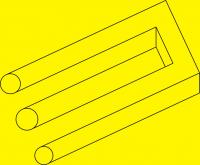×
Forum Header
On Backlash compensation and outcomes
- Zig
- Offline
- Premium Member
-

Less
More
- Posts: 124
- Thank you received: 1
12 Apr 2011 07:10 #8788
by Zig
On Backlash compensation and outcomes was created by Zig
I am presently helping a friend convert a manual chinese bench top milling machine.
Conversion is based on keling steppers and drivers.
So far motors fitted and machine runing.
Milling holes results in some distoriton ( almost rectangles with rounded corners ) when of certain diameter.
Checked and measured backlash.
X axis approx 0.53mm Y axis 0.23m .
Modified the .INI files such that the acceleration settinge as per recomendation ( tried both a factor of 1.5X and 2X )and applied the respective backlash numbers to axes.
Net outcome when milling holes is eliptical paths as opposed to rounded rectangles previously.
One of the holes is quite round the other couple holes have this pronounced elipticity.
Gcode contain R rather than IJ circle definition if thats of any importance.
QUESTIONS:
What is the range of backlash values the simple BACKLASH = compensation scheme will handle with some success?
Why do I end up with an elipse post compensation rather than a circle?
Conversion is based on keling steppers and drivers.
So far motors fitted and machine runing.
Milling holes results in some distoriton ( almost rectangles with rounded corners ) when of certain diameter.
Checked and measured backlash.
X axis approx 0.53mm Y axis 0.23m .
Modified the .INI files such that the acceleration settinge as per recomendation ( tried both a factor of 1.5X and 2X )and applied the respective backlash numbers to axes.
Net outcome when milling holes is eliptical paths as opposed to rounded rectangles previously.
One of the holes is quite round the other couple holes have this pronounced elipticity.
Gcode contain R rather than IJ circle definition if thats of any importance.
QUESTIONS:
What is the range of backlash values the simple BACKLASH = compensation scheme will handle with some success?
Why do I end up with an elipse post compensation rather than a circle?
Please Log in or Create an account to join the conversation.
- Rick G
-

- Offline
- Junior Member
-

Less
More
- Posts: 27
- Thank you received: 155
12 Apr 2011 10:10 #8794
by Rick G
Replied by Rick G on topic Re:On Backlash compensation and outcomes
Hello,
Have you tried just milling a straight line and measuring the outcome on both x and y?
Besides the backlash is there excess flex?
Different speeds result in different results?
Conventional and climb cut give same results?
Have you tried using I J instead?
Not sure how far backlash comp can go and still be practical, but I have tried it pretty high.
Rick G
Have you tried just milling a straight line and measuring the outcome on both x and y?
Besides the backlash is there excess flex?
Different speeds result in different results?
Conventional and climb cut give same results?
Have you tried using I J instead?
Not sure how far backlash comp can go and still be practical, but I have tried it pretty high.
Rick G
Please Log in or Create an account to join the conversation.
- andypugh
-

- Offline
- Moderator
-

Less
More
- Posts: 23450
- Thank you received: 4985
12 Apr 2011 11:32 #8796
by andypugh
Replied by andypugh on topic Re:On Backlash compensation and outcomes
Zig wrote:
I have no feel for how eliptical your circles are, or how large they are relative to the measured backlash.
Did you measure it in more then one position along the leadscrew? Are you milling the holes at the same position on the leadscrew?Checked and measured backlash.
X axis approx 0.53mm Y axis 0.23m .
I am not sure, but making a leadscrew map is likely to work better.What is the range of backlash values the simple BACKLASH = compensation scheme will handle with some success?
Are very big circles drawn with a marker pen properly circular? I am just wondering if the axis scales are actually correct.Why do I end up with an elipse post compensation rather than a circle?
I have no feel for how eliptical your circles are, or how large they are relative to the measured backlash.
Please Log in or Create an account to join the conversation.
- BigJohnT
-

- Offline
- Administrator
-

Less
More
- Posts: 6999
- Thank you received: 1176
12 Apr 2011 11:49 #8798
by BigJohnT
Replied by BigJohnT on topic Re:On Backlash compensation and outcomes
With that much backlash I would at least check the play in the double nut or refit with a ball screw. Definitely do not try and climb mill with that much backlash...
John
John
Please Log in or Create an account to join the conversation.
- Rick G
-

- Offline
- Junior Member
-

Less
More
- Posts: 27
- Thank you received: 155
13 Apr 2011 09:59 #8832
by Rick G
Replied by Rick G on topic Re:On Backlash compensation and outcomes
You might try checking to see if in fact you are losing steps, and if so where.
If you find you are losing steps only with the backlash compensation on then you can try reducing the MAX_VELOCITY and adjusting the MAX_ACCELERATION of the Axis that is losing steps.
I find that if the backlash is consistent for the travel of the axis backlash compensation should work well, however if there is a fair amount of variation of the backlash across the travel of the axis mapping may work better.
Rick G
If you find you are losing steps only with the backlash compensation on then you can try reducing the MAX_VELOCITY and adjusting the MAX_ACCELERATION of the Axis that is losing steps.
I find that if the backlash is consistent for the travel of the axis backlash compensation should work well, however if there is a fair amount of variation of the backlash across the travel of the axis mapping may work better.
Rick G
Please Log in or Create an account to join the conversation.
Time to create page: 0.140 seconds
